
archives for 10/2016
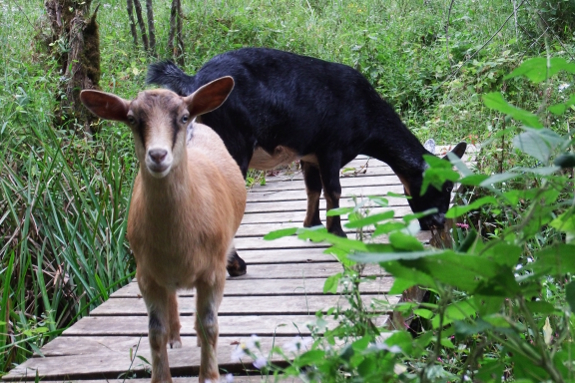
I'd been planning on
breeding Artemesia again this fall because conventional wisdom has it
that the very earliest a doeling should be bred is 7 months and that
even that is dicey. However, conventional wisdom also has it that you
can breed a doeling when she's attained 70% of her adult weight. A
session with the weight
tape this week
turned up the information that Aurora is already 77% as heavy as her
mother and is, in fact, the weight Artemesia was at her first birthday.
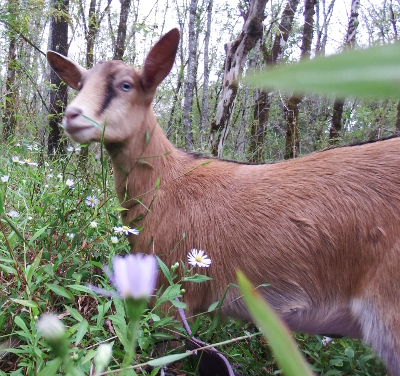 Now, some of that weight is fat.
I've been lax on chasing Aurora away from her mother's dinner and those
concentrates, combined with browse and lots of milk, mean our baby is
pretty darn chubby.
Now, some of that weight is fat.
I've been lax on chasing Aurora away from her mother's dinner and those
concentrates, combined with browse and lots of milk, mean our baby is
pretty darn chubby.
Still, I'm starting to
think maybe we should put her growth spurt to good use. If we breed
Aurora this fall, then Artemesia can gain back her milking weight at
her leisure and take a year off while Aurora loses some of her excess
weight the natural way.
I'd be curious to
hear from experienced goatkeepers. Would you breed a big, fat goatling
at her earliest possible breeding date or hold her over to the next
year for safety?
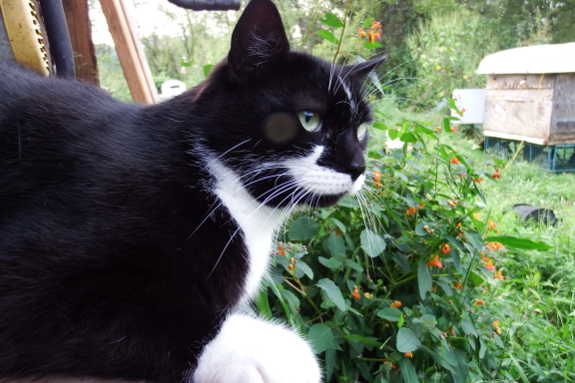
To balance out the Huckleberry post from earlier I recycled this photo of Strider.
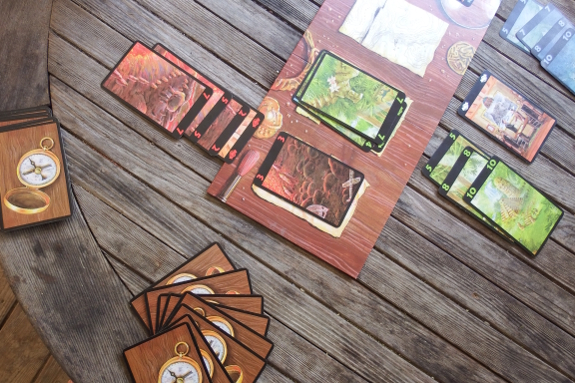
A week of hummingbird
diet (low fiber, low fat, frequent small feedings) plus imodium has
given me a new lease on life. I'd forgotten what it was like to be able
to think straight!
A trip to the
gastroenterologist has confirmed that I'm on the right track. If I can
keep my current regularity while weaning myself off the imodium, I can
slowly ease myself back onto my beloved vegetables over the next few
weeks.
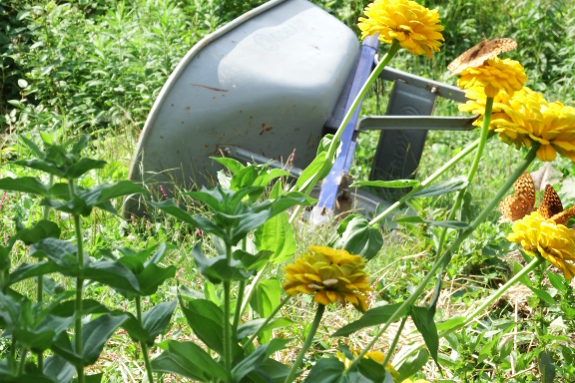
That said, I'm not
planning on diving right back into the daily grind. As Mark points out,
the beauty of an independent homesteading lifestyle is that you can
change your schedule to give your body the rest it needs.
Biological causes aside,
I strongly believe I brought this entire episode on myself by getting
stressed out this summer and then pushing through farm and business
tasks that could jolly well have waited until I healed.
Yes, the farm won't be
as perfect if I keep to my current schedule of only working half time
(and not even that if my bowels complain). But what's the point of
living on a perfect homestead if I'm too sick to enjoy it? Hopefully I
won't forget this important lesson when my dreams get bigger than my
muscles and I'm once again tempted to take on too much.
Our mini
mushroom log experiment
showed some impressive fruiting yesterday.
We thought having a smaller
area to colonize would prompt fruiting a little sooner compared to a
full size log, but it seems the pace is the same as the big logs.
I wonder how much a fruiting log like this would bring at a Farmers
Market?
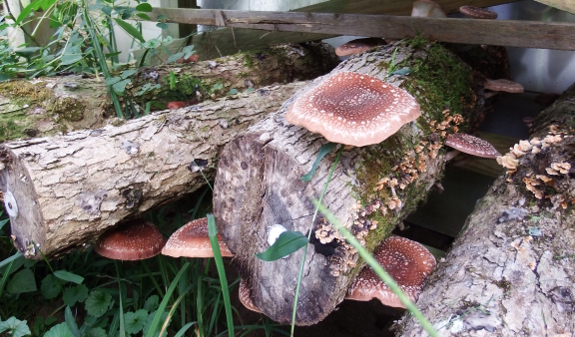
Despite its lack of an
evocative name, the WW70
shiitake really came through for us this week. Temperatures
dropping into the mid-40s in the recent past set the logs off into a
heavy flush. Field and Forest Products suggests the strain will keep
producing deep into the fall...which means we're, for the first time,
going to have to decide how to preserve shiitakes!
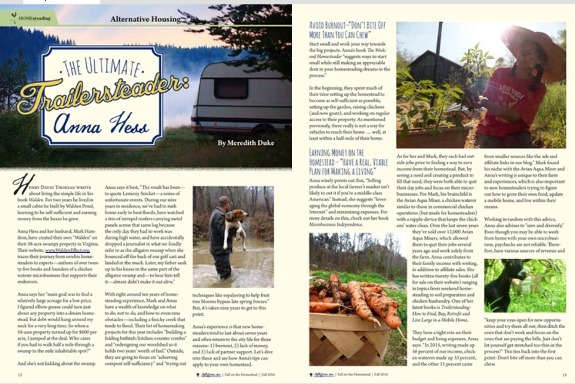
I was intrigued to
discover that the magazine in which I was recently profiled is based in
Gray, Tennessee, only an hour down the road from our farm. The newish
periodical has a fun feature where you can read the current issue
online too. Perhaps you'd like to check
it out?
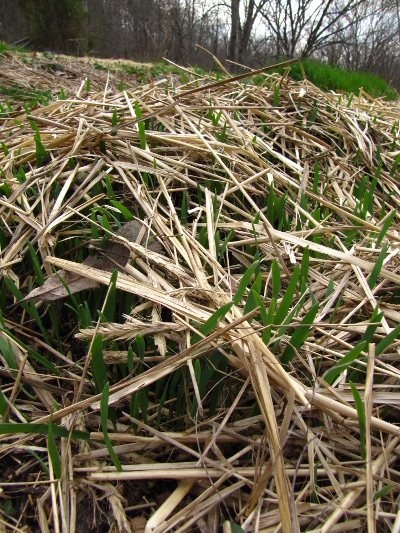 I got a great comment from
asaf this week, and I'd like to answer it here bit by bit just in case
another Southerner is considering a similar cover-crop experiment.
I got a great comment from
asaf this week, and I'd like to answer it here bit by bit just in case
another Southerner is considering a similar cover-crop experiment.
"Goals: weed suppression, soil improvement, erosion control. Crop: 1. oats/vetch/clover. 2. oats for straw.
"The ground will be lightly plowed after the first rains in mid October. I plan to hand-broadcast the seeds and need a good solution for how to cover them afterwards."
I've had good luck
simply sprinkling a light coating of straw over the ground after
broadcasting cover-crop seeds. The straw is enough to confuse the birds
and keep the seeds damp as they germinate, but not enough to prevent
the seedlings from growing toward the light. The photo above, from Homegrown
Humus, shows the
density of straw I recommend.
Now, back to asaf....
"Essentially, I will be creating a 1/5 acre compost pile that is low enough to not necessitate turning and covered by straw on top to preserve moisture and smother the cover crop.
"I plant to plant a variety of vegetables into this. The bulk will be corn into the vetch rows, and peanuts into the pure oat rows. Might do a batch of radishes before the peanuts as a quick spring crop to suppress nematodes."
Unfortunately,
smother-killing is going to be a tough call for the species mixtures
you plan. Most clovers and vetches are perennials, which means they'll
grow back vigorously after cutting. And in your Deep South location,
the oats aren't going to naturally winter-kill for you the way they do
here.
In your shoes, I'd
recommend some combination of the following:
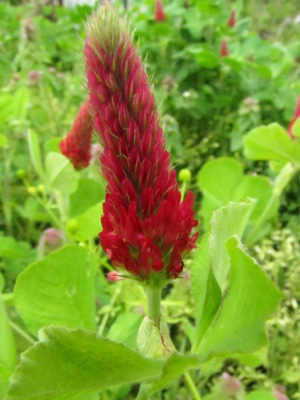 Your pure-oats area will be the
easiest to manage. If you wait
until the oats achieve full bloom and then mow them very close to the
ground, they will hopefully die for you. I haven't done this myself
since our oats naturally winter-kill, but we
use this method with rye
with good success.
Your pure-oats area will be the
easiest to manage. If you wait
until the oats achieve full bloom and then mow them very close to the
ground, they will hopefully die for you. I haven't done this myself
since our oats naturally winter-kill, but we
use this method with rye
with good success.
- If you tweak your legume species a bit, you might have better luck ensuring they perish on command. Crimson clover is an annual that is reputed to mow-kill reliably at bloom. I haven't tried that myself, but my father (in zone 8) has told me that his crimson clover naturally dies after going to seed, then the seeds don't sprout back until the fall. So you might get away with letting crimson clover become a no-work, winter cover crop that comes back year after year.
- If all else fails, you can solarize your
cover crops after cutting them close to the ground in the spring.
This is probably more realistic on your scale than the kill mulches I
use on smaller expanses of plants-that-refuse-to-die.
I hope that helps, and I
also hope you'll report back with some pictures and notes as your
experiment progresses! I adore cover-crop experiments and would love to
see how yours pans out.
Today we moved all the dried sweet potatoes inside for Winter storage.
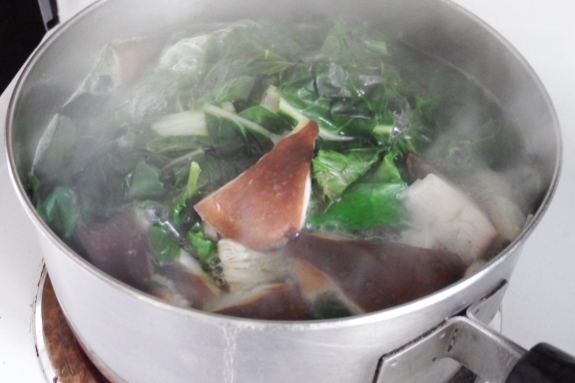
My doctor was vague
about how long I should stay on my hummingbird
diet ("not
forever"), but the internet suggests I need to be prepared for 4 to 6
more weeks of low-fiber and daily imodium. So where are all of my
vitamins and minerals going to come from when the only fruits and
vegetables in my diet are bananas and applesauce? (Yes, I'm taking
multivitamins, but I don't really trust them to do the trick.)
After some
experimentation, I discovered that homemade juice had too much fiber
and homemade chicken stock (even with the fat skimmed off) had too much
fat. Both went on my no list.
Luckily, storebought juice suits my stomach better...but even the
non-tomato-based "vegetable" juice is mostly fruit sugars. However, I
discovered that I could stew up certain vegetables --- notably leafy
greens and shiitakes --- then drain off the water and mix it with
storebought juice for a tasty and nutritious treat. I guess I'll be
drinking my vegetables this month after all.
These new Enterprise
apples have everything going for them.
1. High yield
2. Disease and fungal
resistant
3. Storage friendly
4. Attractive exterior
5. Crispy with a complex
sweetness that is delicious
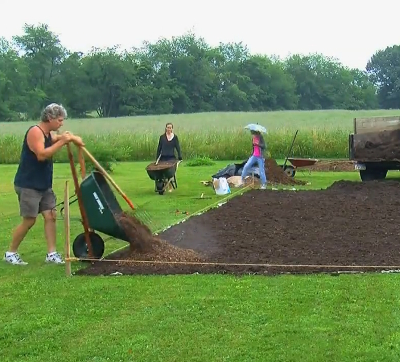 "If you are fielding cover crop questions,
could you please speak to the compatibility of that concept with
no-till gardening (Back to Eden concept with wood chips). I live in the
north with great availability of wood chips. I'm not certain how to
combine the two methods. Thank you!"
"If you are fielding cover crop questions,
could you please speak to the compatibility of that concept with
no-till gardening (Back to Eden concept with wood chips). I live in the
north with great availability of wood chips. I'm not certain how to
combine the two methods. Thank you!"
For those unfamiliar
with the concept, the Back
to Eden system is similar to the the instant no-till techniques I
outline in Small-Scale No-Till
Gardening Basics (which is available in print as part of The Ultimate Guide to Soil).
Basically, you lay down a cardboard kill layer in new ground, top it
off with three to four inches of compost, then add wood chips on top as
mulch.
Okay, back to merryann's
question. It is tricky to choose cover crops
that suit no-till gardening, but luckily there are several that work
well once you weed out the problematic species. The tricky part is
making sure you select cover crops that are easy to kill, either with
winter cold (probably a good choice for you), mowing at bloom time, or
hand weeding out. My top choices given those
constraints are buckwheat for summer, oats and oilseed radishes for
late summer planting with optimal fall growth, and rye for full winter
and spring coverage.
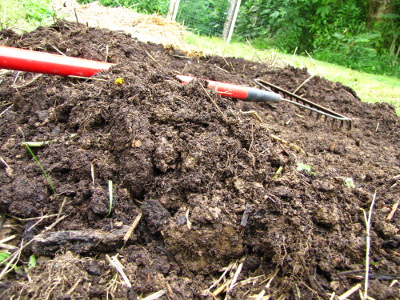 The only major difference between the Back to
Eden garden and my version of no-till from a cover-crop point of view
is using wood chips instead of straw for mulch. You'll want to rake
back the wood chips to expose bare ground before planting your cover
crops, and since wood chips will likely smother your seedlings in a way
straw won't I'd also rake
back a bit of the compost/topsoil as well. After sprinkling your
cover crop seeds, just pull the excess soil back over top (leaving the
wood chips along the edge of the bed) and you're good to go!
The only major difference between the Back to
Eden garden and my version of no-till from a cover-crop point of view
is using wood chips instead of straw for mulch. You'll want to rake
back the wood chips to expose bare ground before planting your cover
crops, and since wood chips will likely smother your seedlings in a way
straw won't I'd also rake
back a bit of the compost/topsoil as well. After sprinkling your
cover crop seeds, just pull the excess soil back over top (leaving the
wood chips along the edge of the bed) and you're good to go!
I'd love to see your
Back to Eden garden full of cover crops. I hope you'll drop back by
next year once you have photos to share!
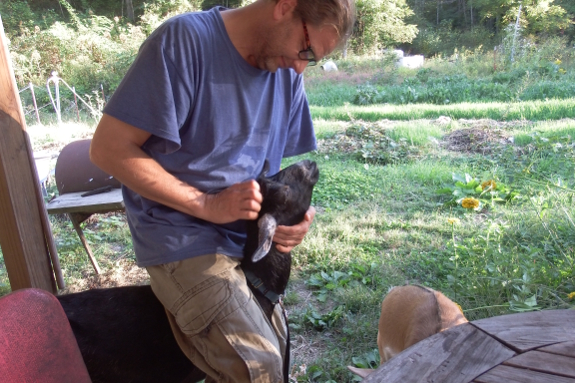
We got all caught up on goat
boluses yesterday.
Each time gets a little
easier.
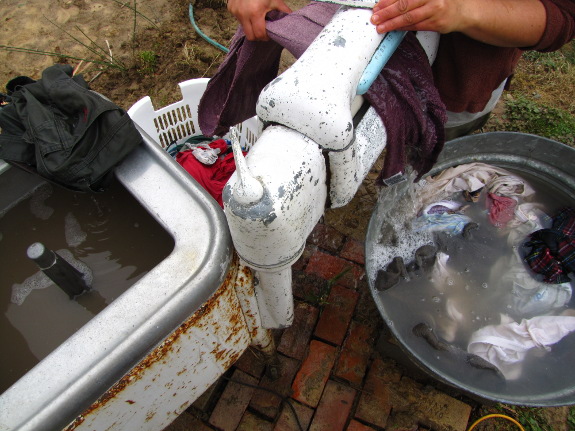 When you live in an average
American home, you don't bat an eyelash at filling space with a
conventional washing machine. But in a tiny house, the math is
considerably different. Once you factor in room to open up the door, a
4.2-cubic-foot, front-load washer uses up nearly ten square feet, which
would be almost 2% of the floor space in our small
home!
When you live in an average
American home, you don't bat an eyelash at filling space with a
conventional washing machine. But in a tiny house, the math is
considerably different. Once you factor in room to open up the door, a
4.2-cubic-foot, front-load washer uses up nearly ten square feet, which
would be almost 2% of the floor space in our small
home!
Given that data, you'll
be unsurprised to learn that we've spent the last ten years washing
with alternative devices. My favorite for a long time was the ancient wringer
washer that Mark's grandmother gave us...which has the massive
benefit of being able to live outside. I've really enjoyed open-air
washing, too, but have to admit that since I've been sick, I've wished
certain things around here were a little easier. Specifically, exterior
wringer washers have the disadvantage of freezing your fingers off in the
winter and taking about three times as many active minutes as a
traditional washer.
So why can't you just
put a traditional washing machine outside? We learned the hard way
during our early years on the farm that conventional washing machines
never drain fully. The pump that moves water out of the wash chamber
keeps a bit of liquid in it even after being done, and that leftover
water freezes and busts the surrounding machine in the winter months.
Please don't repeat our mistake --- it's wasteful and it just won't
work.
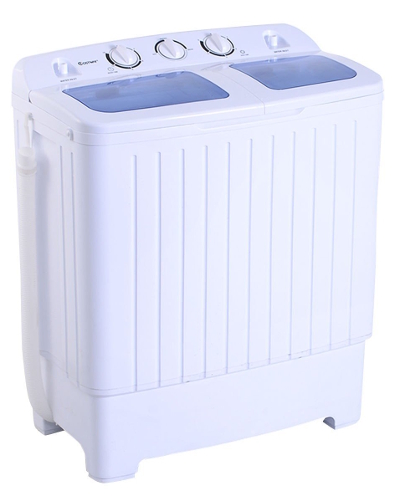 Enter a new class of washing
machine that I'd never seen before --- the portable, semi-automatic washer.
These little cuties are meant to be filled and emptied with hoses and
are light enough to easily move outside after use. Best of all, the
model shown here gravity drains, which means it shouldn't have a
freezing issue if we opt to store it on the porch between loads. Even
if you keep the washer inside at all times, it uses a mere quarter of
the floor space of the average front-load washer, so it's a great
choice for apartment dwellers as well.
Enter a new class of washing
machine that I'd never seen before --- the portable, semi-automatic washer.
These little cuties are meant to be filled and emptied with hoses and
are light enough to easily move outside after use. Best of all, the
model shown here gravity drains, which means it shouldn't have a
freezing issue if we opt to store it on the porch between loads. Even
if you keep the washer inside at all times, it uses a mere quarter of
the floor space of the average front-load washer, so it's a great
choice for apartment dwellers as well.
Of course, there are
always downsides. You'll note I called this little device
"semi-automatic" --- that's because you have to manually move your
clothes into a different compartment for the spin cycle and must run
separate wash and rinse cycles. I have a feeling this will be a good
compromise between space constraints and time use and will also suit
our tendency to accumulate dirty clothes slowly, allowing us to run
several small loads per month rather than saving up for one big laundry
day. Stay tuned and I'll report back in once we've given it a spin!
We felt some fringe effects of the hurricane which prompted backdoor Winterization.
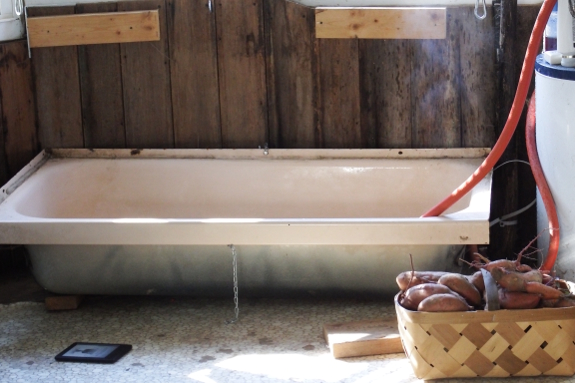
The frost-free date is
fast approaching --- time to take
those storage vegetables inside!
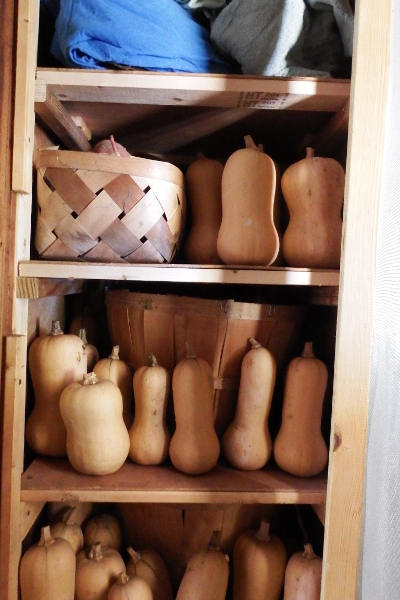 Unfortunately, the butternut
closet that Mark made me last year quickly filled up with odds and
ends over the course of the summer once its original inhabitants had
gone into goat and human bellies. I cleaned out two-thirds of the
space, but wanted to leave the towels and sheets on the top shelves for
safe keeping. So what was I to do with the other 2.5 bushels of sweet
potatoes and butternut squash?
Unfortunately, the butternut
closet that Mark made me last year quickly filled up with odds and
ends over the course of the summer once its original inhabitants had
gone into goat and human bellies. I cleaned out two-thirds of the
space, but wanted to leave the towels and sheets on the top shelves for
safe keeping. So what was I to do with the other 2.5 bushels of sweet
potatoes and butternut squash?
For now, the least
likely specimens are living under the counter atop the convertible
bathtub and under the dining
table (not yet in use since we're still dining on the porch). I'm
feeding the starchy food sources to Artemesia as fast as I can, both to
get weight back on our goat before she's bred and to clear up the floor
space before cold temperatures drive us back inside. Despite living
amid my goat fodder, I find it hard to complain about four bushels of
sweet potatoes and nearly an equal number of butternut squash. The
garden certainly did a good job this year when it comes to storage
vegetables!
I want our new chicken
tractor to have big wheels.
The plan is to make these 26
inch wheelchair wheels work.
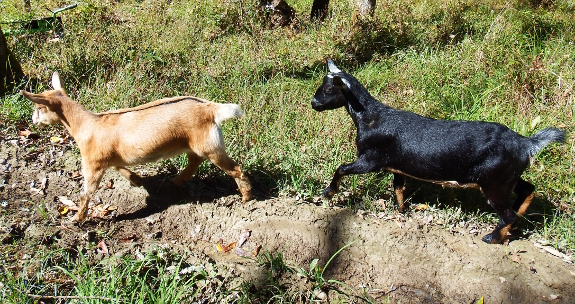
With a low that dipped
just barely into the 30s Saturday night, I developed a sudden affinity
for sun. The girls didn't mind at all going out to enjoy the subsequent
warm afternoon --- in fact, they led the way.
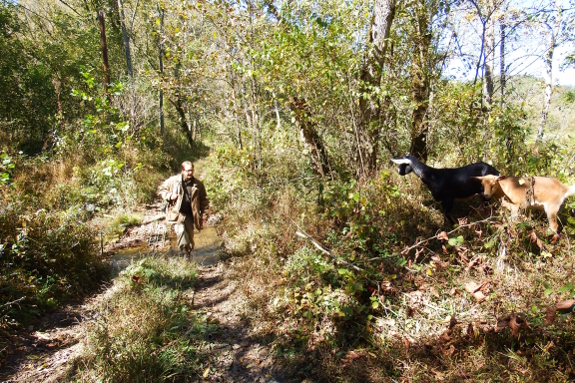
Mark had gone to meet
his mom for lunch, so we all welcomed him home at the ford. The only
problem with this plan is that Artemesia detests seeing any sort of
herd split apart. When Mark veers off toward the trailer while I take
the girls back to their paddocks, she wavers for a moment before
obediently following my lead.
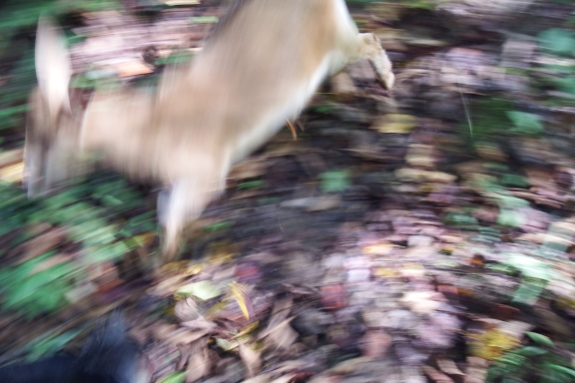
One of these days, I'll
snap a good shot of our darling does dancing. But I suspect you can
feel Aurora's joy in this photo despite the lack of focus.
Another wonderful day
with goats!
 If you're on my email list,
you might have taken part in a poll recently --- which
homesteading-related magazines do you like to read? I thought our wider
audience might enjoy the results:
If you're on my email list,
you might have taken part in a poll recently --- which
homesteading-related magazines do you like to read? I thought our wider
audience might enjoy the results:
1. Mother
Earth News won by a
landslide, with 79% of our readers frequently checking out this
well-known magazine.
2. Hobby
Farms and Backwoods
Home tied for second
place. Interestingly, only two readers subscribed to both of these
runners-up --- I suspect you're either a hobby farmer or a backwoods
farmer, and never the twain shall meet. (I'll bet you can guess which
camp I'd fall into.)
3. Grit came in a close third.
Other magazines enjoyed
by at least two of my readers include: Molly Green, Backwoodsman,
Countryside, Backyard Poultry (one of my personal favorites), Back
Home, Small Farmer's Journal, Organic Life, Permaculture International,
and Taproot.
Want to join in the fun?
You can record your vote here and see up-to-the-minute
results afterwards. Happy reading!
Stowed away 9 bales of good looking greenish hay for Winter goat feeding.
 Several
of you have asked for a followup on my health. I'm pleased to report that
after 2.5 weeks on imodium combined with a very low fiber and fat diet,
I'm doing a lot better.
Several
of you have asked for a followup on my health. I'm pleased to report that
after 2.5 weeks on imodium combined with a very low fiber and fat diet,
I'm doing a lot better.
As proof of healing, my
body is slowly letting me add more fat into my diet, which in turn
allowed me to increase my calories back to the recommended level as
long as I eat in small meals every two hours. Almost instantly my
energy and brain power returned.
The next step is to
slowly wean myself off imodium. I'm taking this week by week --- last
week I cut back to 67% of the previous imodium dose and today I'm down
to 50%. Let's hope that sticks!
In the meantime, I'm
gradually adding the "safest" fruits and vegetables back into my diet
to replace the juices and teas
which I'd been using as sources of vitamins and minerals previously.
It's a slow add --- for example, last week, I started by trying half of
a peeled plum as the day's total additional dietary intake. That
worked, so I increased to a whole peeled plum the next day, which also
stuck. Soon, I'll try peeled and boiled-to-death carrots, then perhaps
some raw lettuce or citrus (with membranes removed).
I appreciate everyone's
well wishes and I hope you know that I couldn't have kept my spirits up
without you. Kayla and Mom particularly --- you have been rocks in the
turbulent sea of my life this summer and I get so much out of your
frequent doses of love. Thank you all for being on my team!
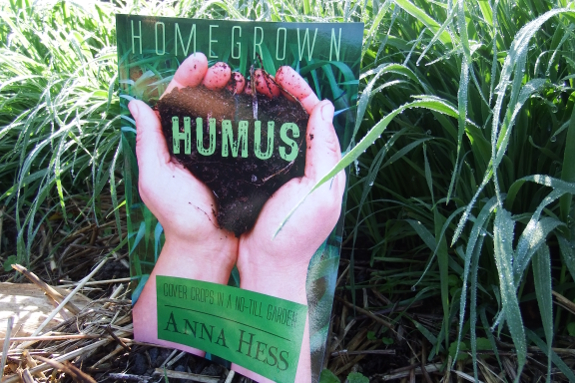
I've been hoarding
a couple of cover-crop experiments, planning to include them in a revamped
version of Homegrown Humus. But, on rereading, I decided that the
simplicity of the existing ebook will make it easier for new gardeners
to dive into cover cropping. So, I set the current words in stone by
turning them into a print book (it's new and cheap ---
check it out!) and will be sharing those additional experiments here on
the blog instead.
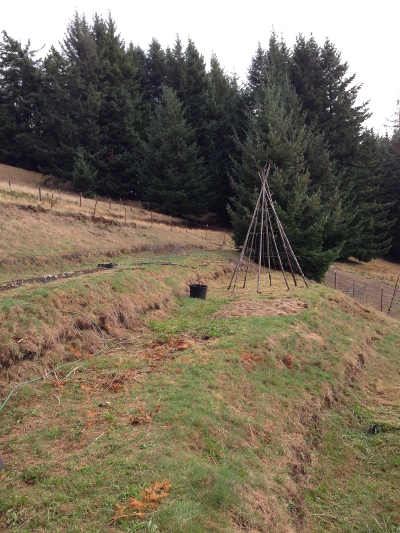 The first of my off-farm experimenters was
Charity, who homesteads in zone 9 along the coast of Oregon. At the
time she was experimenting (18 months ago), her garden consisted of
weeds rather than bare soil, so she embarked on what basically
consisted of modified pasture cropping --- mowing the grass down
close to the soil, broadcasting cover-crop seeds, then raked the seeds
into the top of the soil as best she could before waiting to see what
would grow.
The first of my off-farm experimenters was
Charity, who homesteads in zone 9 along the coast of Oregon. At the
time she was experimenting (18 months ago), her garden consisted of
weeds rather than bare soil, so she embarked on what basically
consisted of modified pasture cropping --- mowing the grass down
close to the soil, broadcasting cover-crop seeds, then raked the seeds
into the top of the soil as best she could before waiting to see what
would grow.
Unsurprisingly given
those tough growing conditions, Charity saw a lot of problems with
establishment and growth. The soil was very dry when she planted and
nothing sprouted for a couple of weeks until the first fall rains came
to call. By that point, rodents and birds had done a number on the
seeds (especially the oats), so her stands were moderately to very
patchy.
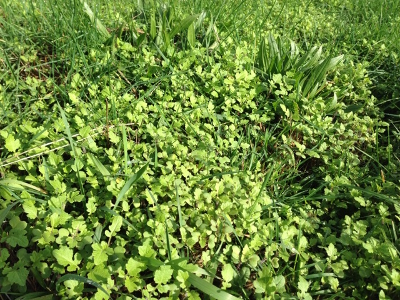 Nevertheless, Charity was able
to pick out a few winners that did well despite the initial germination
issues combined with low soil fertility. Barley, fava
beans, and white mustard all made the cut to be tried again, with
the last being handy for early-spring planting since plants bloomed and
were ready to mow-kill early in the spring season.
Nevertheless, Charity was able
to pick out a few winners that did well despite the initial germination
issues combined with low soil fertility. Barley, fava
beans, and white mustard all made the cut to be tried again, with
the last being handy for early-spring planting since plants bloomed and
were ready to mow-kill early in the spring season.
Thanks for sharing,
Charity! Hopefully other gardeners in the Pacific Northwest and
elsewhere will get some ideas from your well-recorded experiments.
It was dry enough today to
run the sprinklers all afternoon.
After using the new tripod
sprinklers this Summer we
are ready to conclude they are a worthy upgrade to our garden
irrigation system.
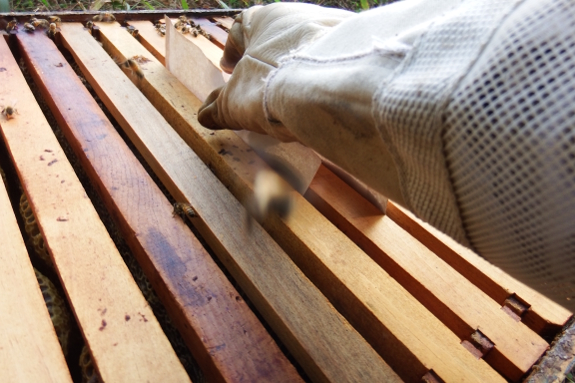
When
I checked our hives for mites a month ago, the Warre hive passed with
flying colors. The Langstroth hive, on the other hand, had more varroa
mites than I would have liked...but not quite enough for immediate
intervention. So I decided to take a wait-and-see approach.
After a month of wait,
it was time to see. A second mite count this week showed that counts
had increased a bit but not dramatically in both hives. Still, with a
47 mites/day fall in the Langstroth hive, I opted to try out the rhubarb
home remedy we heard
about years ago.
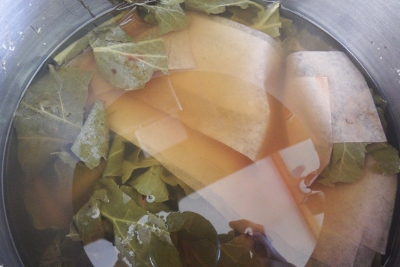 To that end, I took two of
the last rhubarb leaves remaining in the fall garden and stewed them in
water for a couple of hours. Then I turned off the heat and let sheets
of printer paper soak in the water for a while before taking them out
to dry.
To that end, I took two of
the last rhubarb leaves remaining in the fall garden and stewed them in
water for a couple of hours. Then I turned off the heat and let sheets
of printer paper soak in the water for a while before taking them out
to dry.
Finally, I opened up the
Langstroth hive for the last time of the year. While counting honey
stores, I found the quite small brood area and slipped the homemade
varroa strips in between the frames. I suspect the bees will chew and
remove the strips in relatively short order, so only time will tell
whether the remedy has any effect. Let's see if I can remember to do
another mite count in the middle of November to gauge the results.
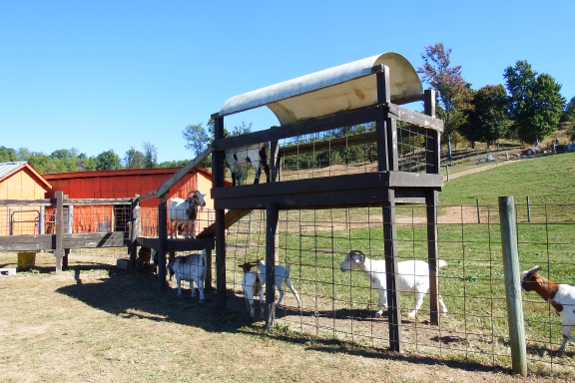
Our friend Walter at the
Punkin Patch has a neat structure for his goats to climb on.
It also doubles as a shady
spot for some of the afternoon.
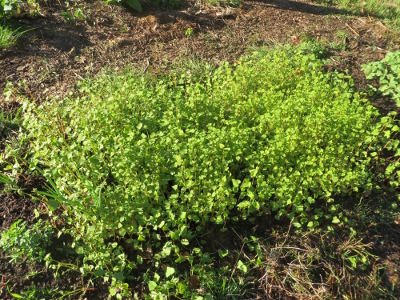 In the Deep South, the garden
year is entirely different from what most of us are familiar with. My
second cover-crop experimenter, Sara, gardens in zone 8 along the gulf
coast of Louisiana, and she was able to grow what I think of as summer
cover crops in October, November, and December of 2014.
In the Deep South, the garden
year is entirely different from what most of us are familiar with. My
second cover-crop experimenter, Sara, gardens in zone 8 along the gulf
coast of Louisiana, and she was able to grow what I think of as summer
cover crops in October, November, and December of 2014.
I sent Sara several
different types of seeds to play with, but the only ones that sprouted
and grew were oilseed radishes, buckwheat, and sunflowers. That last
didn't make the cut as a cover crop due to excessive seed predation
(the reason we now start our sunflower seedlings inside), but they did manage to keep growing until
a hard freeze hit in early January. Buckwheat wasn't quite so hardy,
but the plants managed to suppress weeds until the first light frost at
the beginning of November.
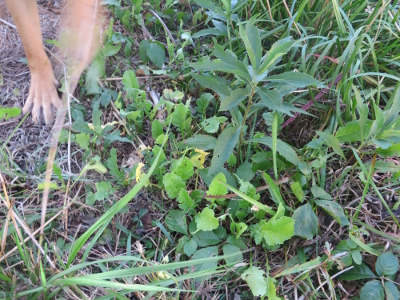 Oilseed radishes are more of a
traditional winter cover crop and in previous years, Sara has really
enjoyed the amount of biomass the radishes produced in her forest
garden. Unfortunately, during the study period the plants didn't do as
well in her main garden, probably due to late planting (October 10).
Oilseed radishes are more of a
traditional winter cover crop and in previous years, Sara has really
enjoyed the amount of biomass the radishes produced in her forest
garden. Unfortunately, during the study period the plants didn't do as
well in her main garden, probably due to late planting (October 10).
You can read more about
Sara in her profile in Trailersteading.
Or check out the new print edition of Homegrown
Humus for tips on incorporating cover crops into your own growing
year.
We've driven the Kubota a
little over 30 miles since the beginning.
I topped off the tank when it
got down to half way recently and estimated that the average mileage
for our style of driving is 7 MPG.
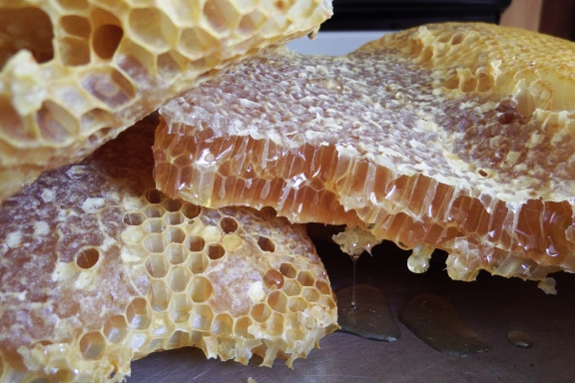
Adding
rhubarb strips to the hive was only of secondary importance when I
delved into our apiary this week. My primary purpose was to make sure
that the bees had socked away enough honey to make it through the
winter.
Last
month, the Langstroth hive was 25 pounds low, so I decided to feed
them sugar water just in case the fall flowers weren't sufficient to
make up the difference. But my brain went fuzzy and I mostly forgot to
feed them --- I think I might have given them about ten pounds of
sugar, all-told.
Luckily for me, the bees
knew what to do. The Langstroth hive is now at about 43 pounds while
the Warre hive has nearly the exact same amount (without supplemental
feeding).
Or it did until I pulled
out one frame of honey for us that was all alone in an otherwise
empty box. That's a major downside of the Warre hive --- it's tough to
switch frames around to consolidate living quarters in winter, and this
time I figured it was better to take a bit of extra honey rather than
making the colony heat a largely useless box all winter long.
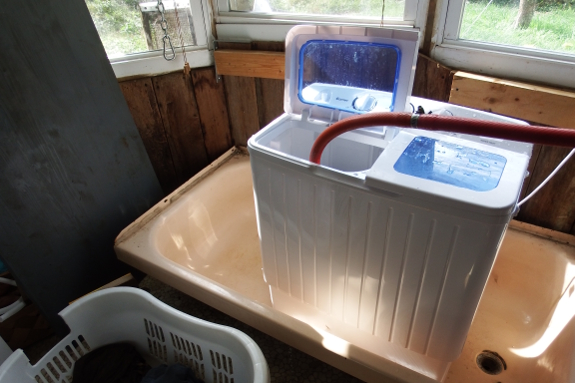
Our new washing machine arrived...and I got so
excited I washed pretty much everything I own immediately. After four
loads of laundry, I'm ready to give my review --- I love it!
Please keep in mind I've
been using a wringer washer for the last ten years, so I have no clue what
someone accustomed to a modern American washing machine would think.
But I was pleasantly surprised by the capacity (about half of a normal
load for me), thrilled by the agitation (clothes end up three times
cleaner than in the wringer washer), and impressed by the spin cycle
(non-jeans end up dry enough to finish when draped overnight in the
house).
The model I purchased
does have a lint trap, which is a bit fiddly but pulls out about 60% of
the lint. On a less impressive note, the instructions are fascinating
as a study in computer translation but are nearly unreadable --- good
thing there's a how-to video in the Amazon reviews. The gravity drain
system is more positive and removes enough water that I'm pretty sure I
can safely store the machine on the porch.
Overall, I'm thrilled
with our choice and look forward to dirtying up some more clothes in
the near future. Definitely a good addition to our homestead!
I've noticed how our Red Rangers have been lounging instead of ranging these last couple weeks before their retirement date.

While Kayla and I were
touring Punkin Patch farm last week, we enjoyed a view of the rye field
that will provide our homestead's straw in 2017. So green against the
autumn brown!
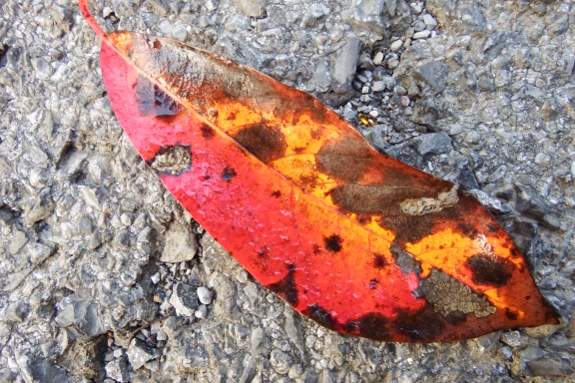
The autumn color in our
valley tends toward yellows rather than the fiery reds and oranges
you'll see up high. But a few blackgums and other startling leaves
trickle in.
According to my weather
guru, fall
is officially running a little late this year...and I don't mind one bit.
A few extra weeks to clean up the garden and slaughter broilers before
the frost hits is much appreciated.
This past week has been the week walnuts have decided to do their Winter drop.
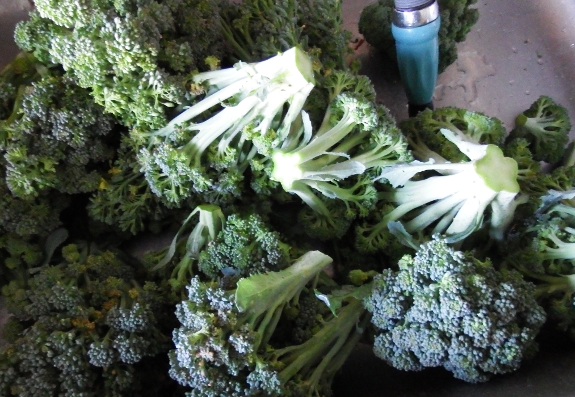
This continues to be our
best year ever for broccoli. Most of the increased yield is due to
starting the seedlings inside and setting them out at the exact right
time from a weather point of view. But this mellow fall has also helped
since our second crop has been able to bulk up huge and copious
after-florets, producing a crop twice as big as the one a month before.
I still can't eat
broccoli, but Mark's been enjoying the tasty treat at least four times
a week for months now. We're also filling the freezer for a time when
my gut is more pleasant and broccoli is once again back on my menu.
(And, yes, I had one very vivid dream about consuming broccoli, so at
least I'm getting micronutrients in my sleep. What, that's not normal?)
The chicken knife is going on 3 years now and is still a good, safe cut.
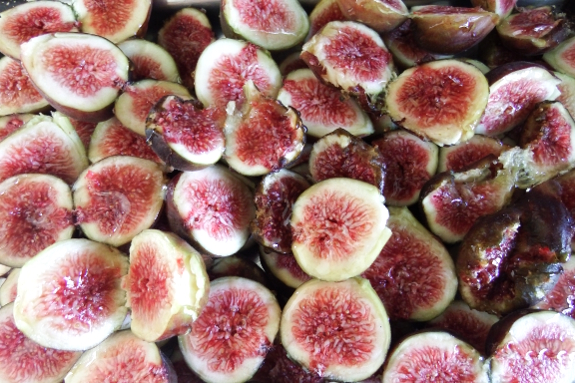
I thought I was on the
mend with my hummingbird
diet...and then I started trying to add a few foods back in and it
all went to pot. This is the trouble with uncontrolled
experiments where you change more than one variable at a time.
Luckily, you can always come up with a new hypothesis and try again.
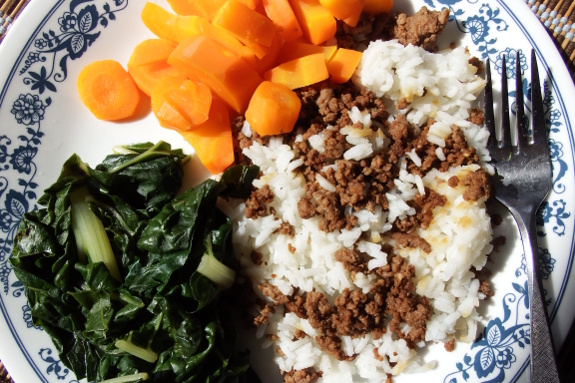
So I pored over the
internet some more and came up with another alternative ---
carbohydrates known as FODMAPs could be irritating my gut. I was leery
at first of adding back in delicious ingredients that I'd assumed had
far too much fat or fiber for my bowels to handle. But I was thrilled
to learn that aged cheeses, oranges, clementines, lettuce, leafy
greens, and carrots have all been well received down there as long as I
cook the last two into submission to increase digestability. I almost
feel like I'm eating real food again!
The plan this time
around is to do two weeks of a severely restricted FODMAP diet, then
begin trialing the five categories one per week. In case you'd like to
start a betting pool, I'm guessing I don't have issues with lactose or
galactans but do with fructose and, to a lesser extent, polyols and
fructans. Don't you love home science experiments?
A good place to be on a rainy day like today is a wooden platform with your Mom.
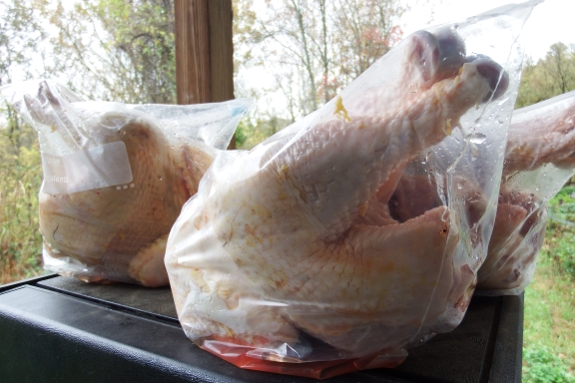
Last year, we
were overall quite pleased with our Red Ranger broilers, but I
wished their fat was more yellow than white. Did the fault lie in the
breed (which forages a lot more than a
Cornish Cross, but a lot less than a "normal" chicken) or in the time
of year? To answer that question, we started our chicks a month earlier
in 2016 so they'd bulk up while the grass was still green and bugs were
still copious.
This week, we harvested
half of our current flock. Unfortunately, the fat is still white,
pointing to breed as the culprit.
Despite the lower
quality fat, I still think Red Rangers are a good compromise for the
average homesteader. They're relatively efficient converters of feed to
meat, don't die like Cornish Cross, and do produce succulent meat that
doesn't require special cooking techniques like heirloom breeds do.
All of that said, in the
interest of cutting back our workload so I don't stress myself out
again next summer, Mark and I decided to outsource our broiler
production to the same folks who provide our pastured lamb each year.
So...back to Cornish Cross we go!
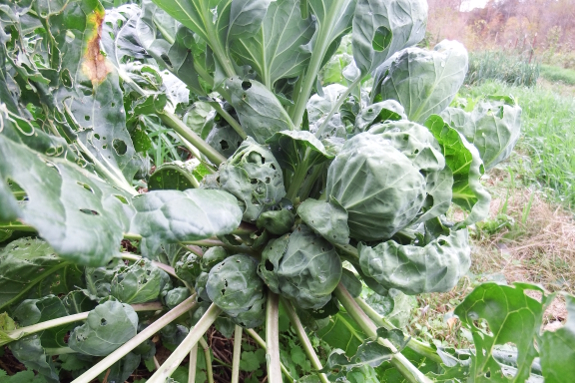
I'm still figuring out
the best time to top brussels sprouts to promote sprout formation. In
previous years, I've topped them too late (November), so it didn't do
much good. This year, though, I'm pretty sure I topped too early, as
you can see in the image above --- the sprouts on the topped plants are
turning into new shoots instead of bulking up into edible mini-cabbages.
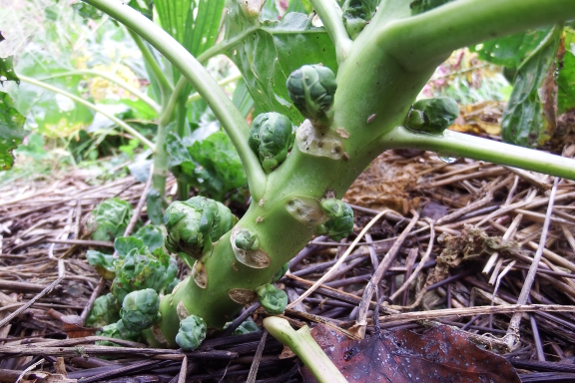
Luckily, I only topped a
few of the biggest plants. In contrast, smaller, untopped plants are
bulking up sprouts as usual. So maybe I should have topped in early
October instead of mid
September.
Next year....
I took this picture while
recording sound for a classmate's project yesterday.
It seems like you can never
have too many AA batteries when you shoot all day.
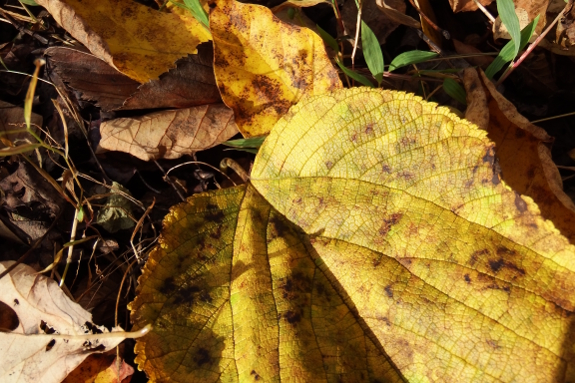
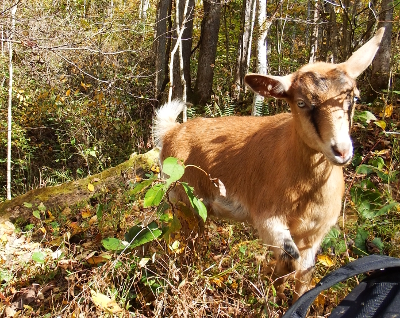 I
started to write that our first frost was late this year. Then I went
back to look at the six years I've been keeping track:
I
started to write that our first frost was late this year. Then I went
back to look at the six years I've been keeping track:
2011 - 10/3
2012 - 11/3
2013 - 10/21
2014 - 10/31
2015 - 10/17
2016 - 10/23
Hmmm, looks like this
frost is right on schedule. No more figs or peppers, but no more summer
weeds either. Time to light a fire in the woodstove and relax into fall.
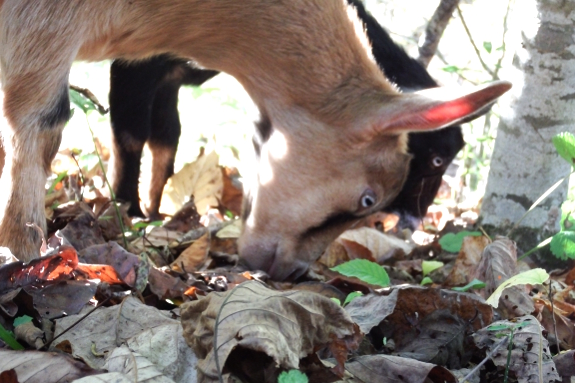
After the first frost,
the leaves start to fall faster.
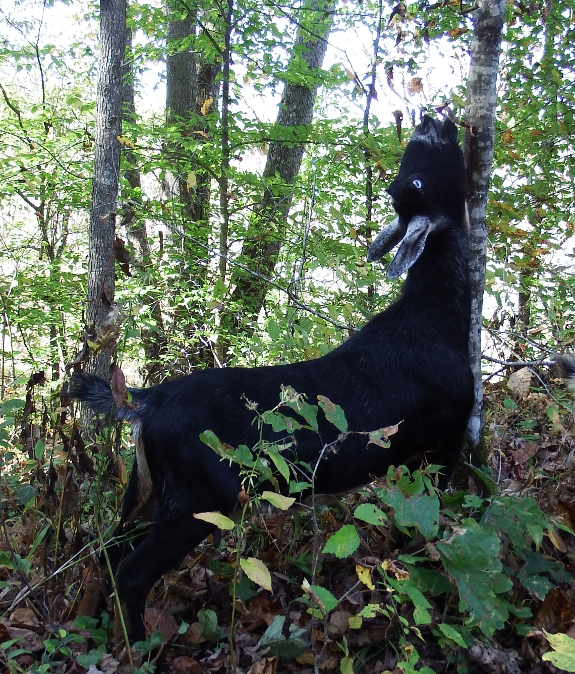
The goats and I are both
intent upon collecting as many as possible as fast as possible.
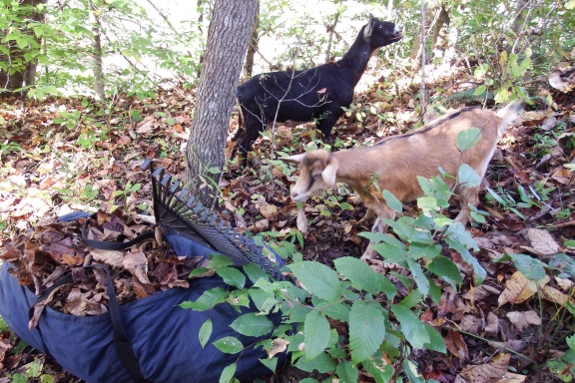
Our methods differ a
bit, though. I rake and bag so I can easily transport my haul back to
the chicken coop.
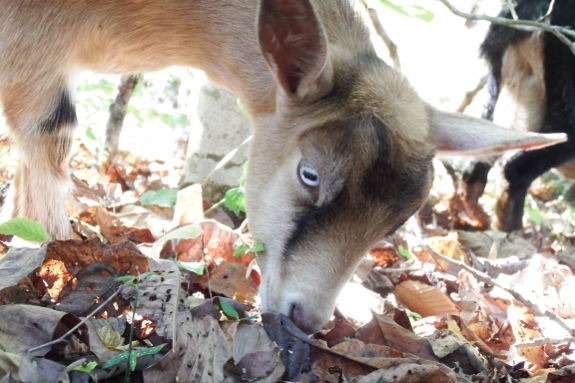
Artemesia and Aurora
just nibble, nibble, nibble to digest at their leisure.
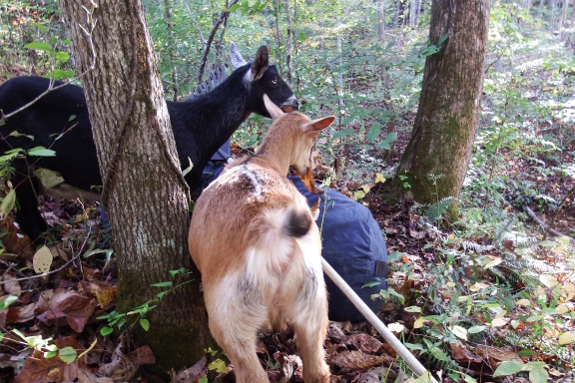
We both get the job
done, though...as long as nobody cheats!
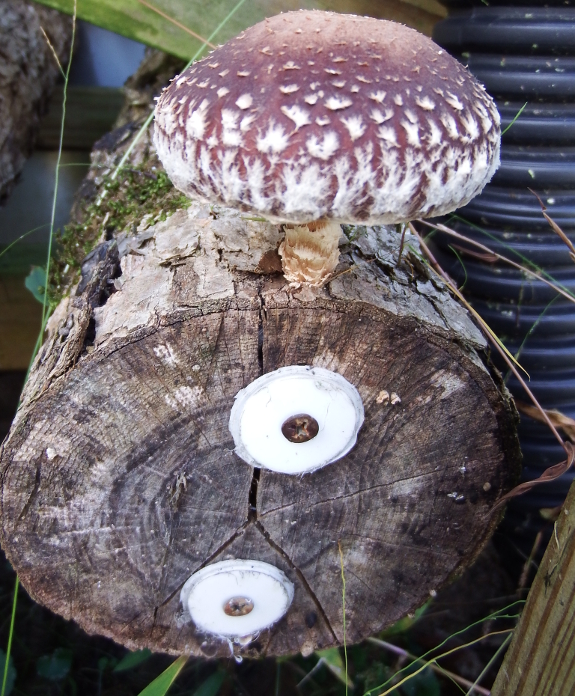
We've used a couple of
different techniques to label mushroom logs over the years. Previously,
we cut squares out of flashing material and scratched a number on each
one. That worked well...except sometimes it was hard to read the
scratched number and sometimes the sharp edges cut into my hands.
Better has been a very
simple system using plastic circles that we accumulate while making EZ Misers. One
circle is WW70, two circles is Snow Cap, and three circles is Native
Harvest. Aside from having to check my key every time I want to know
which variety is currently fruiting, the new technique has been
trouble-free.
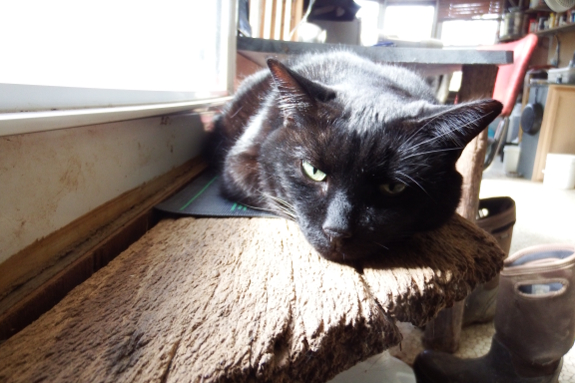
What do you do with an
electric seed
mat when not warming seedlings?
Move it to the cat ledge
where Huckleberry can feel warm and special.
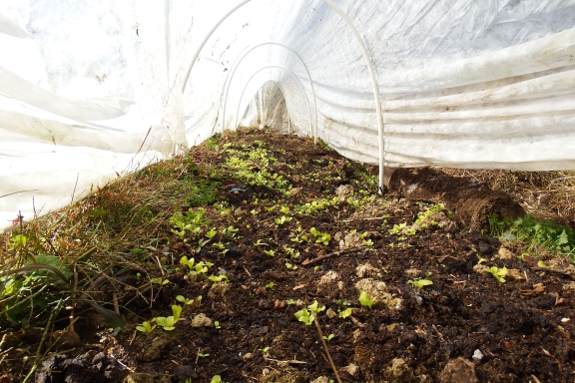
After the first frost,
our weather decided to embark upon a series of frosty mornings. Time to
put up the first quick hoop to protect the Christmas
lettuce!
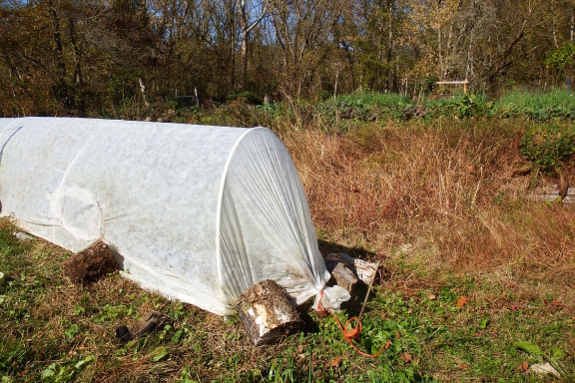
We'll wait for our
second quick hoop, over the long row of kale at the top of this photo,
until the weather chills down a little further. For now, I like the
easy access of a bed that's open to the air.
I noticed some fig leaf curl
this week.
Time to start thinking about fig
tree Winter protection.
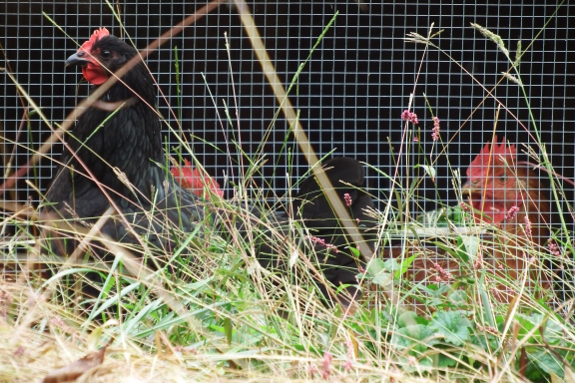
We usually either hatch
our own layers or buy unsexed chicks, but this year we decided to take
the easy way out. We ordered fifteen pullets and one cockerel as
chicks, figuring we'd replace our laying flock without having to kill
all the excess males.
Unfortunately, predators
picked off two of our chicks during their first month of life. And one
of those chicks was the rooster-to-be.
Most of our roosterless
pullets have settled into their hen-party life just fine. But two were
boy crazy. They kept flying fences to hang out with the broiler boys in
the other set of pastures, so we eventually just let them move right in.
Slowly but surely we've
been picking off their paramours, though. And, on the final day, the
boy-crazy hens got so confused they flew out of the pasture they'd
begged to be in so they could chat with the cockerels in the holding
pen, waiting for freezer camp.
What will our boy-crazy
hens do now that there are no roosters left on the farm? Only time will
tell. I'm hoping they'll move back in with their sisters. If not, it'll
be time for a tractor time out.
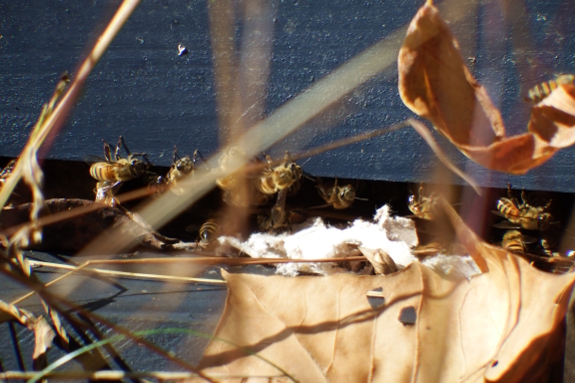
Two weeks after treating
our Langstroth hive with rhubarb-infused
paper strips, it was time for the moment of truth --- had varroa
mite counts increased, decreased, or stayed the same in the face of the
treatment?
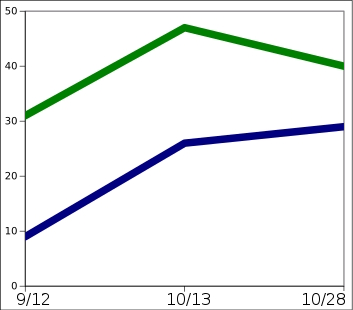 The
graph to the left shows the results (blue line is the untreated Warre
hive and green line is the treated Langstroth hive). Over the last two
weeks, the Warre mite count continued to increase, albeit at a
decelerated pace, while the Langstroth mite count actually went down.
The
graph to the left shows the results (blue line is the untreated Warre
hive and green line is the treated Langstroth hive). Over the last two
weeks, the Warre mite count continued to increase, albeit at a
decelerated pace, while the Langstroth mite count actually went down.
Of course, these few
data points aren't really enough to prove anything. Maybe the
Langstroth hive is merely cutting back its brood chamber the way bees
always do in the autumn while the Warre hive is a bit behind. Maybe the
mites per bee haven't changed in either hive at all.
Still, it's a heartening
trend, suggesting that rhubarb strips might be a valid alternative to
other types of varroa-mite treatment in borderline hives. The big
question will be --- which hive is doing better in the spring?
Normally I can carry a
chicken under each arm when moving them around.
Our Red Rangers this year
were so feisty I only carried one at a time.
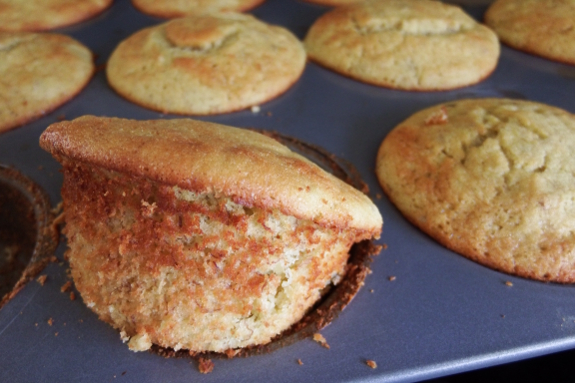
A
low FOD-MAP diet has worked wonders on my irregular digestive
system. To celebrate being off imodium after a month of daily use, I
thought I'd share a recipe that has been a staple of my diet as I've
been working on letting my gut heal --- banana rice-flour muffins.
Ingredients:
- 4 very ripe bananas
- 4 eggs
- 1 tablespoon of baking powder
- 0.75 teaspoons of salt
- 2 tablespoons plus 2 teaspoons sugar
- 1-2/3 cups rice flour (brown or white --- I use half of each to keep the fiber at a gut-friendly level)
Preheat the oven to 350
degrees and butter a 12-muffin tin. (You can bake these in a loaf pan
like banana bread, but the texture is much better in muffin tins.)
Discard the skins and
mash the banana flesh, then add the eggs and beat until somewhat
fluffy. This is the most important step for making tasty muffins ---
too fluffy and the flour won't incorporate properly; not fluffy enough
and the muffins turn into rocks.
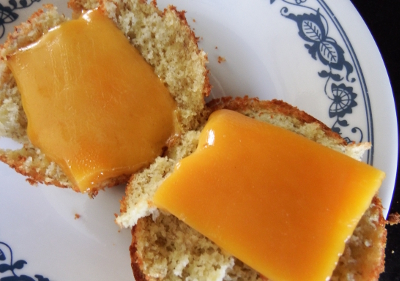 Add everything else and mix well.
Then fill each muffin well to the brim and bake until the tops are
slightly brown and a knife comes out clean.
Add everything else and mix well.
Then fill each muffin well to the brim and bake until the tops are
slightly brown and a knife comes out clean.
I enjoy these plain, but
more often I eat them sliced in two and microwaved with a piece of
cheddar cheese on each half. Very mildly sweet and relatively
wholesome, these little morsels make my grumpy gut decidedly more
friendly.
After two more applications over the last year the Lucas power steering stop leak finally did its job at stopping the leak.
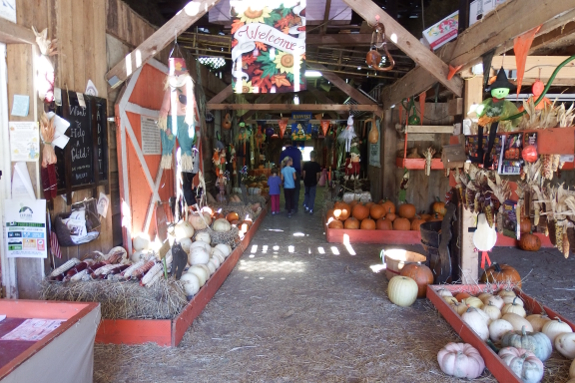
A couple of weeks ago,
Kayla and I headed over to the Punkin Patch Farm
for a girls' day out. I'd never seen so many pumpkins in one place!
Baby D. chose a tiny one just the right size to toss from her stroller,
Kayla chose a white one, and I stuck to plain old orange.

I hadn't carved a jack
o'lantern in about twenty years, so the result wasn't particularly
artistic. Once I stuck in a candle I'd found floating down the creek,
though, my supposed Green Man at least turned into a menacing face ---
close enough!
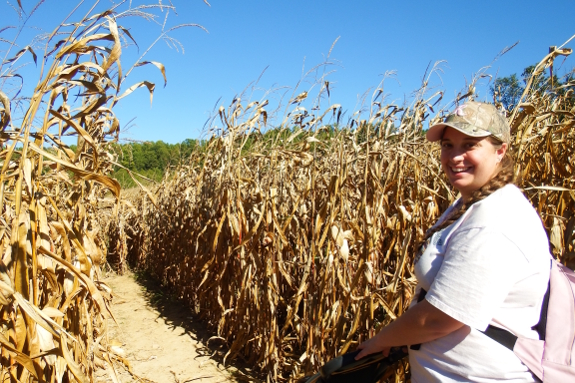
Thanks for spurring on
yet another round of fun, Kayla! Swinging bridges this week?
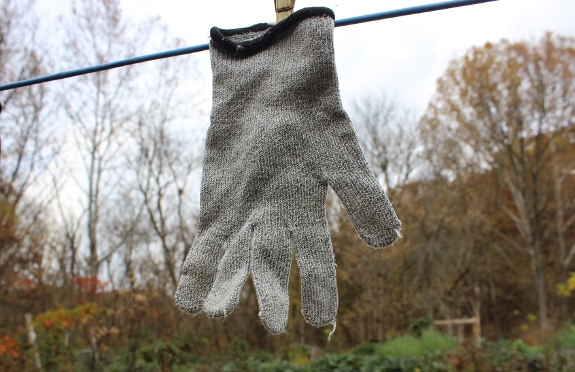
The new cut
resistant glove makes chicken day safer.
It's washing machine safe and
an essential item when retiring chickens with a knife.
Want more in-depth information? Browse through our books.
Or explore more posts by date or by subject.
About us: Anna Hess and Mark Hamilton spent over a decade living self-sufficiently in the mountains of Virginia before moving north to start over from scratch in the foothills of Ohio. They've experimented with permaculture, no-till gardening, trailersteading, home-based microbusinesses and much more, writing about their adventures in both blogs and books.
